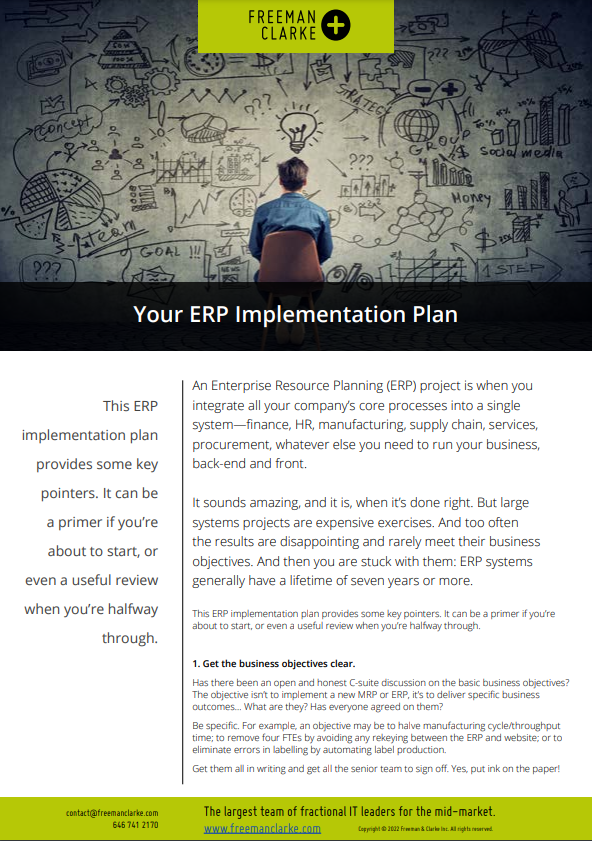Your ERP Implementation Plan
An Enterprise Resource Planning (ERP) project is when you integrate all your company’s core processes into a single system, finance, HR, manufacturing, supply chain, services, procurement, whatever else you need to run your business, back-end and front.
It sounds amazing, and it is when it’s done right. But large systems projects are expensive exercises. And too often the results are disappointing and rarely meet their business objectives. And then you are stuck with them: ERP systems generally have a lifetime of seven years or more.
This ERP implementation plan provides some key pointers. It can be a primer if you’re about to start, or even a useful review when you’re halfway through.
You may also be interested in our blog post Do You Actually Need an ERP Project?

Your ERP Implementation Plan
This ERP implementation plan provides some key pointers. It can be a primer if you’re about to start, or even a useful review when you’re halfway through.
Download now for FREE!1. Get the business objectives clear.
Has there been an open and honest C-suite discussion on the basic business objectives? The objective isn’t to implement a new MRP or ERP, it’s to deliver specific business outcomes… What are they? Has everyone agreed on them?
Be specific. For example, an objective may be to halve manufacturing cycle/throughput time; to remove four FTEs by avoiding any rekeying between the ERP and website; or to eliminate errors in labelling by automating label production.
Get them all in writing and get all the senior team to sign off. Yes, put ink on the paper!
2. Be clear about the key requirements.
In everyday business language, document the key things the systems must do, or must enable, or must achieve. This might be a list of forty or fifty statements, such as, “telesales handling staff can see accurate stock info and pricing on any products
within thirty seconds.”
Often the emphasis is on how you go about things today, but the focus should be on outcomes, as there may be better ways to get there. And all department heads need to be involved, to agree, and, again, to sign off.
3. Get specific about who is involved and who is accountable.
First, pick the right people to own the project. Are there experts on the business who will need to be assigned to the project team? Will their positions need to be covered?
And don’t assume that every techie in your business understands ERP projects. Increasingly the line is blurred between shop-floor technology, automation, and information technology. The operations team (who might have owned this project a decade ago) may no longer have the right skills or experience.
Second, everyone must be clear on their roles. Are you aiming to involve some of your own people in the details so they can become expert superusers of your new system? Who is accountable for delivery? This should include not only delivery of the technology, but all the business outcomes identified at the start.
4. Get clear on the cost-benefit model.
Although you don’t know the detailed costs yet, you can establish the cost-benefit model. This means understanding how this project will deliver solid benefits, so that when compromises are necessary, you can identify what’s worth keeping and what you can drop. The cost-benefit should be based on improvements in Key Performance Indicators (KPIs). For example, identify the target on-time, in-full (OTIF) and compare to current measurements of the same KPIs.
5. Select your products rationally.
There are hundreds of systems available: IFS, Nav, AX, SAP, SAGE, Epicor, Oracle, Syspro to name a few! This can be a minefield, but not if you’re clear-headed about it. Once you have all your requirements, you can use them to create selection criteria, a
scoring system, and clear questions to ask.
You need to weigh up the advantages of integrated ERP with multiple specialized systems, which might offer better features but greater complexity. Make sure all the business stakeholders are part of the decision-making process so they all have a vested interest in success.
6. Select your partners rationally.
A partner will configure, customize, and support your systems. As you will need to have a long-term relationship, it is critical that there is trust and a good cultural fit. Get references, and check everything! Ask around: are they experts in your sector? Are
they financially stable? Do they have a stable team, or has there been turnover?
And start early, so that you have time to negotiate a good price and contract rather than having to cave in due to pressing deadlines.
To continue reading, download the article above.
Visit our ERP and Integration Issues Knowledge Center which includes all content related to this topic.